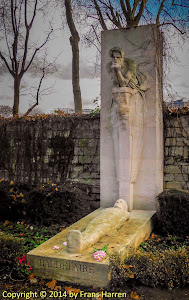Charles Baudelaire
Charles Pierre Baudelaire (April 9, 1821 – August 31, 1867) was a French poet who also produced notable work as an essayist, art critic, and pioneering translator of Edgar Allan Poe. His most famous work, Les Fleurs du mal (The Flowers of Evil), expresses the changing nature of beauty in modern, industrializing Paris during the 19th century. Baudelaire's highly original style of prose-poetry influenced a whole generation of poets including Paul Verlaine, Arthur Rimbaud and Stéphane Mallarmé among many others. He is credited with coining the term "modernity" (modernité) to designate the fleeting, ephemeral experience of life in an urban metropolis, and the responsibility art has to capture that experience.
See: wikipedia
Montparnasse Cemetery
Cimetière du Montparnasse is a cemetery in the Montparnasse quarter of Paris, part of the city's 14th arrondissement.
History
Created from three farms in 1824, the cemetery at Montparnasse was originally known as Le Cimetière du Sud (Southern Cemetery). Cemeteries had been banned from Paris since the closure, owing to health concerns, of the Cimetière des Innocents in 1786. Several new cemeteries outside the precincts of the capital replaced all the internal Parisian ones in the early 19th century: Montmartre Cemetery in the north, Père Lachaise Cemetery in the east, and Montparnasse Cemetery in the south. At the heart of the city, and today sitting in the shadow of the Eiffel Tower, is Passy Cemetery.
Notes
Montparnasse Cemetery is the eternal home of many of France's intellectual and artistic elite as well as publishers and others who promoted the works of authors and artists. There are also monuments to police and firefighters killed in the line of duty in the city of Paris. There are also many graves of foreigners who have made France their home.
The cemetery is divided by Rue Émile Richard. The small section is usually referred to as the small cemetery (petit cimetière) and the large section as the big cemetery (grand cimetière).
Because of the many notable people buried there, it is a highly popular tourist attraction.
See: wikipedia













0 comments:
Post a Comment